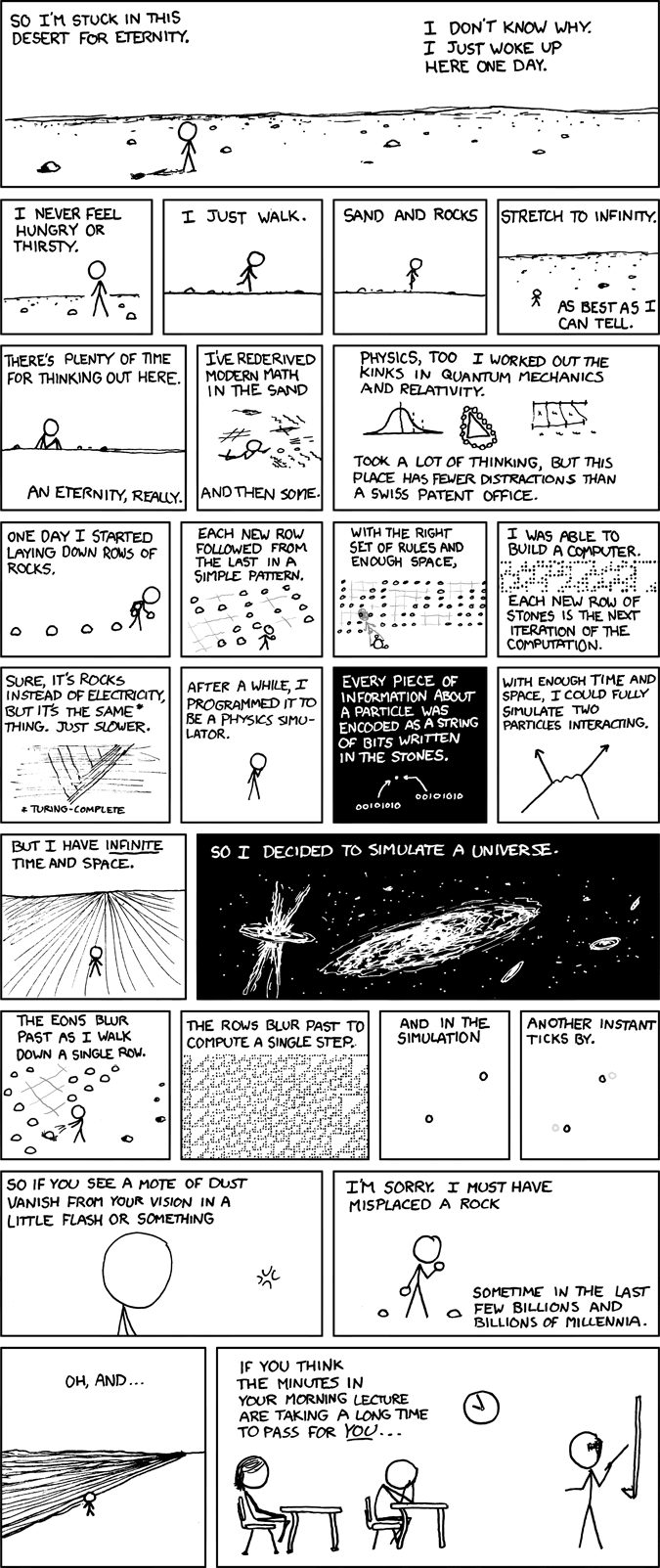xkcd is just fantastic, of course. "A Bunch of Rocks":

More like this
ÐовÑÐ´Ð¾Ð¼Ð»ÐµÐ½Ð½Ñ Ñ Ð±Ð»Ð¾Ð·Ñ Ñ Ð½Ð°Ð¿Ð¸Ñав Ð´Ð»Ñ 10 ÑиÑÑÑ Ð¿ÑаÑÑв, з пиÑÐ°Ð½Ñ Ð¼ÑгÑаÑÑÑ, бÑв пеÑеведений беÑÐµÐ·Ð½Ñ Ruszkowski на ÑкÑаÑнÑÑкий Langauge, Ñ Ð´Ð¾ÑÑÑпний Ð´Ð»Ñ ÐаÑ, Ñоб пÑоÑиÑаÑи ÑÑÑ:
XKCD 505
This is both frighteningly funny, and shockingly profound.
The really worrying thing is how few people in the world will ever get it.
h/t Chad
Crime statistics for the last 12 months in NSW have been released. Most crime categories have decreased significantly.
Surely you jest Dave ... it is well-known that JHWH created Life!
I think my favorite bit of humor was the caption reference to Rule 34... somehow it was strangely appropriate.
Simulating quantum particles using classical rocks? Well, I'm glad he has more time to figure it out than I do.
His simulated quantum universe has a finite temperature ... the associated thermal noise makes it PTIME easy to simulate ... just like our quantum universe?
How does special relativity factor into that?
(Not a rhetorical question: I really know far less computational complexity theory than I should.)
Gentle reminder that I was the arguably first to say in non-science fiction print that we live inside a simulation.
.... "As to the far future, my article on this, which cited Freeman Dyson and others, which first published the idea that we are most likely simulations by a far future dilute electron positron [Hawking radiation] plasma civilization, and which served as the extensively quoted basis (quotation marks accidentally omitted) of some Greg Benford novels, is:
"Human Destiny and the End of Time" [Quantum, No.39, Winter 1991/1992,Thrust Publications, 8217 Langport Terrace, Gaithersburg, MD 20877] ISSN 0198-6686
In fairness to Benford, who I think is being criticized in a blog about that [Cosmic Variance], science fiction writers have been talking about 'life in a simulation' at least since the early 1980s [seriously, and more speculatively in Philip K. Dick and in the 1964 novel Simulacron-3 by Daniel F. Galouye, loosely adapted later to the film "The 13th Floor"] and I dimly recall Dyson as talking about it eons ago.
Prof. Gregory Benford and I have been friends since about the late 1970s. We have done many panel discussions together, and have visited each other's homes. I am not criticizing him. He told me that he read and enjoyed "Human Destiny and the End of Time" and made handwritten notes on it. Some of those notes made it into his brilliant Galactic Core novels, with entirely italicized poetic passages, sometimes using several sentences from my article. He said that he accidentally omitted quotation marks when he quoted me, primarily about far future electron-positron civilizations simulating the ancient days of solid matter, when intelligent beings lived on planets.
Yes, Science Fiction predated some British non-scientist's belated rediscovery of the concept, and it is he (who also hijacked "Transhumanism" from its creators) and his cultist singularitarian followers who are at fault for insufficiently citing prior art. And for defaming myself and some of my illustrious co-authors (such as full professor Philip V. Fellman, and the internet pioneer John Sokol who coined "livecam") and refusing to retract the defamations. In Science Fiction, a union of solipsists and conspiracy of anti-conspirators, that is okay. In refereed journal articles, it is generally unacceptable, as academic protocol.
Hence my professor coauthors and I have to keep repeating that 1991 was the date when it was first in print that we are almost surely simulations running in systems built of Hawking radiation.
We've been repeating that for googols of years.
We'll eventually stop because the temperature of the universe is NOT asymptotic to zero, due to Hawking radiation from the universe's horizon, and our simulation mechanism will eventually cook to death at nanokelvins.
A fully relativistic quantum universe (to field theory and beyond!) would seem to be tricker to simulate with a CA, it seems to me.
Well, the locality of the rocks isn't much of an obstacle for the quantum part: I can throw a rock across the sand dunes and get some funky nonlocal interactions to simulate quantum. But the merging with special (and general) relativity seems daunting.
Either you have a hidden discreteness and hence the special relativity breaks down, or the discreteness is of a more geometric nature (topological possibly?)
Hmmmm ... clearly special relativity breaks down ... because our state-space is observed to be Riemannian and hot, not Minkowskian and cold ... so quantum field theory has to break too ... at both ultra-long scales and ultra-low scales.
So Hilbert space can usefully be regarded just like Minkowsky space ... a linear approximation to the (hot, noisy, curvy) state-space the observed universe ... which includes (hot, noisy, curvy) creatures like ourselves.
Luckily, the mathematics and physics needed to calculate in "curvy" state-spaces are not only beautiful in themselves, and absolutely necessary in cosmology, but also also are of practical use in simulating any hot, noisy quantum system.
Tools that are beautiful *and* useful ... we can't ask for much more than that.